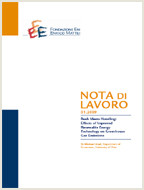Understanding the Consumption Behaviors on Electric Vehicles in China – A Stated Preference Analysis

11.09.2013
Libo Wu, Changhe Li, Haoqi Qian, ZhongXiang Zhang
Q41, Q42, Q48, Q54, Q55, Q58, C65, C83
Electric Vehicle, Nested-Logit Model, Stated Preference Experiment, Willingness to Pay
Climate Change and Sustainable Development
Carlo Carraro
This paper examines how the different characteristics of both electric vehicles themselves and the consumers would influence the consumption behavior on electric vehicles. Data collection is based on the questionnaire design using the orthogonal experimental method and large-scale stated preference survey covering more than 2000 households in 10 central districts of Shanghai. Three types of electric vehicles, i.e. fast charging, battery swapping and slowing charging are investigated according to a set of factors, such as acquisition costs, operation and maintenance costs, charging time and convenience, mileage, preferential policies and so on. We analyze the data with the nested-logit model. Our results suggest that the mode of battery swapping with slowing charging enjoys a relatively higher proportion in Shanghai, though there is no absolutely dominating type. By group classification analysis, the male, the young, the well-educated and the well-paid groups share relatively low proportion of selecting electric vehicles. Furthermore, consumers pay more attention to daily variable usage cost and charging time instead of acquisition costs. All these suggest the necessity for the government to adjust the current supporting policy in order to cultivate the electric vehicle market effectively.
***
Suggested citation: Wu L., C. Li, H. Qian, Z. Zhang (2013), ‘Understanding the Consumption Behaviors on Electric Vehicles in China – A Stated Preference Analysis’ , Nota di Lavoro 79.2013, Milan, Italy: Fondazione Eni Enrico Mattei.
